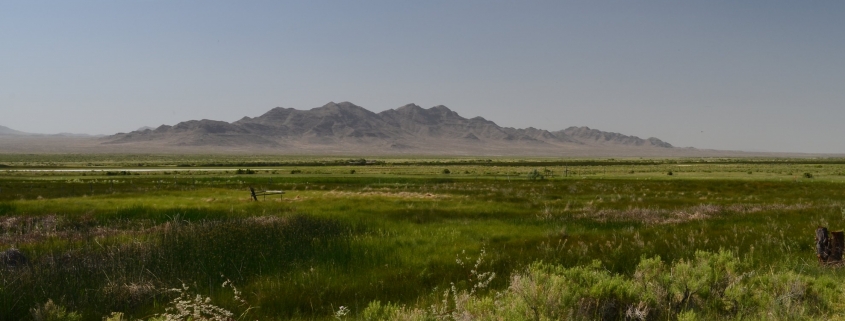Study: Inadequate Groundwater for Current and Potential Demands in Basin Targeted by Las Vegas
Springs, creeks, and wetlands on the Nevada-Utah border are at risk in “worst-case” pumping scenario, U.S. Geological Survey finds.

Snake Valley wetlands. Photo courtesy of Flickr/Creative Commons user Paul Inkenbrandt
By Brett Walton, Circle of Blue
There is not enough water to support important wetlands and springs in a semi-arid desert ecosystem that straddles the Nevada-Utah border if all permitted and proposed groundwater rights are put to use, according to a U.S. Geological Survey study of the Snake Valley. There also may not be enough groundwater to satisfy the desires of the Las Vegas area, whose water agencies have eyed the valley for decades as a potential supply source.
Some 250 miles north of Las Vegas, the Snake Valley is threaded with groundwater-fed springs and wetlands. Those waterways are habitat for threatened and endangered fish species and support the rural area’s ranching and farm operations. The water beneath the valley has also been targeted by the Southern Nevada Water Authority, a regional wholesaler that serves Las Vegas. As the region becomes drier, climate change is putting pressure on water availability for humans and nature.
What happens to this ecosystem and to groundwater levels if pumping increases?
The study, the latest of several recent investigations, modeled the effect on groundwater levels at 47 sites of interest to the Bureau of Land Management and National Park Service. Both agencies manage land in the valley. The study employed a number of scenarios, including a “worst case” that represented the maximum permitted and proposed extraction volumes, said Melissa Masbruch, a USGS hydrologist and lead author of the research.
Sites of interest for the two federal agencies include wetlands, creeks, seeps, wells, and springs.
The potential drawdown is large, Masbruch said, amounting to declines of 300 to 400 feet at most sites of interest in the worst-case scenario. Such a decline could affect groundwater levels and discharge to springs and wetlands at “almost all” of the sites. At some sites all of the discharge that typically feeds a spring or creek would be captured by a well.
The number of sites in which groundwater flows are completely captured depends on how much groundwater is pumped. Masbruch modeled 11 pumping scenarios, which account for irrigation return flows and increasing groundwater extraction. Springs and wetland sites at which all the groundwater flows are captured because of increased pumping range from four (if all current rights are used) to 13 (under the worst-case scenario).
The drawdown does not happen immediately. The model ran the scenarios out an infinite number of years, but most of the groundwater declines occurred within the first 100 years, Masbruch said.
Other studies have linked the survival of certain species in the valley to the availability of groundwater. A paper published earlier this year by a fish biologist at the Utah Division of Wildlife Resources indicates that long-term declines in shallow groundwater will dry up spawning habitat for two threatened fish species.
Neither the Bureau of Land Management nor the National Park Service responded to email and phone messages asking for comment on the study.
Las Vegas’s Plans Also Affected
Current groundwater permits in the valley are for 55,272 acre-feet per year, though the actual volume pumped varies year to year. SNWA has applied to the Nevada state engineer for 50,680 acre-feet per year, according to the study. A preliminary agreement with Utah, which shares the basin, would cap SNWA’s withdrawals at 35,000 acre-feet per year.
The study also looked at how pumping would affect water levels at SNWA proposed diversion sites. Given physical constraints on the resource, the actual volume available to SNWA might be significantly lower than what it seeks, according to the study. The model showed water levels in SNWA’s proposed well locations dropping below the 2,000-foot depth to which the wells would presumably be drilled.
“They aren’t going to be able to pump the full amount out of these wells,” Masbruch told Circle of Blue.
Masbruch found that SNWA’s water withdrawals would need to be reduced by 52 percent to 56 percent, depending on the scenario, to keep water levels above the 2,000-foot depth.
In order not to be constrained, SNWA would have to add more diversion points beyond the nine it currently proposes, Masbruch said. That would spread the pumping across a broader area.
SNWA was not aware of the study until contacted by Circle of Blue, according to Bronson Mack, a spokesperson. Mack said the authority would not be able to comment without time to review the study. The Snake Valley groundwater applications are “not a high priority for us at this time”, he added.
Even if SNWA is granted groundwater rights, Nevada and Utah must reach an agreement on how much pumping will occur. That stipulation is part of a 2004 law signed by Nevada. An attempt several years later at an interstate groundwater compact was shelved in 2013.
Brett writes about agriculture, energy, infrastructure, and the politics and economics of water in the United States. He also writes the Federal Water Tap, Circle of Blue’s weekly digest of U.S. government water news. He is the winner of two Society of Environmental Journalists reporting awards, one of the top honors in American environmental journalism: first place for explanatory reporting for a series on septic system pollution in the United States(2016) and third place for beat reporting in a small market (2014). He received the Sierra Club’s Distinguished Service Award in 2018. Brett lives in Seattle, where he hikes the mountains and bakes pies. Contact Brett Walton













Leave a Reply
Want to join the discussion?Feel free to contribute!